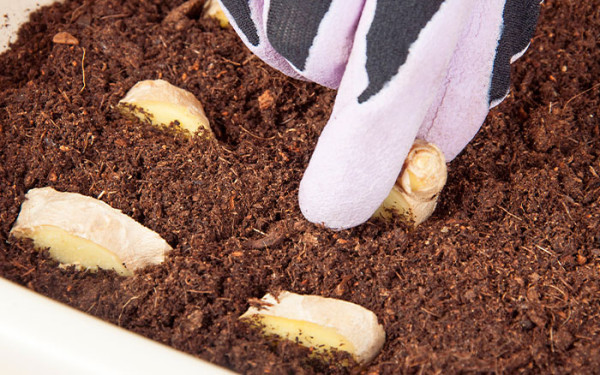Read my guide to growing ginger in the garden.
Zingiber officinale or as it’s more commonly known, ginger, is a tropical spice that is from the same family as cardamom and turmeric. Native to South-East Asia, India, and China, it’s now grown in many tropical climates including Jamaica, Australia, Fiji, and Indonesia. But you can grow it here in the UK too!
If you’ve got a herb garden and want to add something a little different to the mix, start growing ginger. Then you’ll have access to some more homegrown goodness to add taste to your dishes.
Growing ginger
As it’s a plant that grows best in warmer climes, when growing it in the UK it’s best to start growing in spring once the risk of frost has passed. To start off, simply pick up a ginger root as part of your food shopping trip. Pick one that is fresh and ideally has ‘eyes’ which are the small tips where the shoot emerges from. When these ‘eyes’ start to turn green, they are ready to plant.
If you want to try your hand at growing a few plants, the root can be cut into several pieces using a sharp knife. As long as the section has one or more ‘eyes’ on it and is at least 2.5cm in width, it’s suitable to grow into a plant of its own. Once the root has been cut into sections, leave them in a dry place for a couple of days to let a protective layer heal over the cut surface.

Prime position
A sheltered spot with partial shade and well-drained soil is best. As it’s not cold or frost hardy, ginger will grow better indoors, whether that’s in a heated greenhouse or conservatory.
It can be grown in a container with sufficient drainage holes, planting each individual piece around 20cm apart and at least 5cm deep, with the ‘eye’ facing upwards. If you’ve got quite a few pieces to plant, aim for there to be 2 or 3 pieces in each large container. After planting, water the soil lightly and from then on water regularly to keep the soil moist – because wet, sodden soil can cause the root to rot. Feed the ginger with a balanced liquid plant food every 2 weeks through summer whilst it’s actively growing to give it the boost it needs.
The containers can be placed on a sunny patio through the summer months but it’s necessary to keep the container in your home or a heated greenhouse during the colder months to protect it from the chilly outdoors. Alternatively, if it’s planted out in the garden, apply a thick layer of mulch as protection when temperatures drop.
Once the stems have died down in autumn cut them off and the ginger rhizome can be harvested by digging it up. Ensure you leave a few ‘eyes’ on the root so it can continue to grow and supply the tasty spice.

Goodness of ginger
You’ll reap many rewards from growing ginger as it’s incredibly versatile. From savoury stir fries to sweet treats like gingerbread, it can add a warm and spicy taste to a variety of dishes. In fact, gingerbread dates back to the ancient Greeks who added ginger to their bread recipes and created the first ‘gingerbread’.
Not only is it a culinary spice, but it is hailed for its medicinal properties too. Add a bit of ginger to a cup of hot water with a slice of lemon or some honey when you feel a cold coming on. As a diaphoretic, ginger helps to promote perspiration, helping you sweat out a cold. But you don’t need to have a cold, it’s perfect for just warming you up on a cold day!
The benefits don’t stop there as it is even able to relieve pain as the root contains a component, gingerol, which is anti-inflammatory and can help those suffering from arthritis.

Flowering favourites
It’s not just about the flavour because there are ornamental ginger plants that you can grow in your garden to add some tropical and exotic colour. They may not be edible, but you can feast your eyes on their beautiful blooms.
Hedychium (ginger lily) ‘Tara’ is hardy in most of the UK and has fragrant orange flowers that bloom in racemes in summer and autumn. Or for mild parts of the UK, Hedychium densiflorum (dense ginger lily) has cylindrical spikes of peach-coloured flowers that appear in summer. These fragrant flowers complement the long lance-shaped leaves and would look great in a Mediterranean style garden.

Leave A Comment